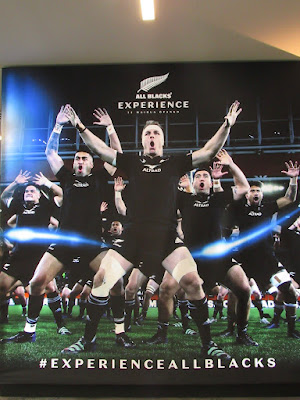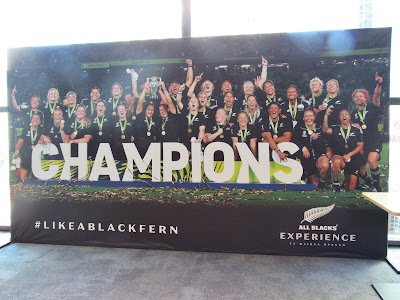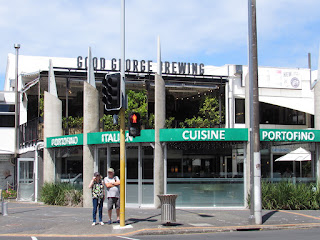New Zealand is a small island nation of 5 million people filled with an ambiance of life and vitality. Auckland, our first stop, presented a big city face with small town ease. Cranes cover the city erecting office and residential buildings. Public works are numerous. The beauty of the water inlets and channels is advantaged. And the city has gone out of its way to represent and respect the Māori heritage after decades of white domination. The Māori have been fighting for their rights for over 100 years, only now are winning thanks to the treaties that were imposed on them. Pride of place is evident here, and Auckland is definitely a great city on the move to the future. If I were younger and unattached, I would surely want to live here.
Tour of the City
 Our first stop on the city tour were the commercial docks--past and present. Actually, investment in the city since 1995 has led more private
landowners to invest huge sums of money, which has significantly augmented
development. Many cranes hover over the
city as residential and industrial structures going up.
Our first stop on the city tour were the commercial docks--past and present. Actually, investment in the city since 1995 has led more private
landowners to invest huge sums of money, which has significantly augmented
development. Many cranes hover over the
city as residential and industrial structures going up.

The Auckland Harbor Bridge carries 170,000 vehicles per day through to its City Center including more than 1,000 buses, which carry 38 percent of all people crossing during the morning peak.
Cornwall Park on Mission Bay
Cornwall Park is located on the shore near the heart of the city. Residents use it the enjoy the clean air and be close to the water.
Cornwall Park surrounds Maungakiekie pa, which is also known as One Tree Hill. The two independent parks form one large park of 670 acres. The Park has centuries-old heritage sites, wide-open spaces, tree lined avenues and walks, places of peace and tranquility in a large city, sports grounds, and a working farm for the education of city children.
 Sir John Logan Campbell, a physician and one of the original Scottish settlers in 1840, gave the park's 230 acres to a private trust on June 10, 1901. The adjoining
Park Maungakiekie had been purchased by the national government in 1845. Since 2012 it has belonged to Ngā Mana Whenua o Tāmaki Makaurau Collective.
Sir John Logan Campbell, a physician and one of the original Scottish settlers in 1840, gave the park's 230 acres to a private trust on June 10, 1901. The adjoining
Park Maungakiekie had been purchased by the national government in 1845. Since 2012 it has belonged to Ngā Mana Whenua o Tāmaki Makaurau Collective.
Settlers
used to graze their cattle and sheep in this area. This area was filled
with wallabees, however, they were shot on sight and are now extinct.
Mission Bay
During World War I, Mission Bay served as a location for the Walsh Brothers New Zealand Flying School as a landing area for their seaplanes. At least a third of
the New Zealand’s pilots active had trained here. Hence,
Mission Bay was also known as ‘Flying School Bay’. The school closed in 1924, after training over 1,000 pilots.
Paratide Drive
Near the parklands on the North Shore is the wealthiest street in Auckland. The houses say it for themselves. The neighborhood's location to the airport also makes it highly desirable and expensive.



Michael Savage Memorial
Michael Savage (1872-1940) was New Zealand's 23rd prime minister and the first Labor Prime Minister. He is commonly known as the architect of the NZ welfare state. He is generally regarded as one of the country's greatest and most revered prime ministers.
Savage was born in colonial Australia and emigrated to New Zealand in 1907. As a laborer, he became a trade unionist and in 1910 was elected president of the Auckland Trades and Labor Council. Savage supported the formation of the New Zealand Labor Party in July 1916 and was active in local politics before his election to the House of Representatives in 1919. He was elected unopposed as Labor party leader in 1933.
 Savage led the Labor Party to its first ever electoral victory in the 1935 election and then in 1938.
He won public support for his government's economic recovery policies
and social welfare program. His government joined Britain in declaring war against Germany
in 1939. Savage's health declined rapidly and he died in office in 1940.
Savage led the Labor Party to its first ever electoral victory in the 1935 election and then in 1938.
He won public support for his government's economic recovery policies
and social welfare program. His government joined Britain in declaring war against Germany
in 1939. Savage's health declined rapidly and he died in office in 1940.
Takaparawhau/Bastion Point
A family picnic on the beach at Bastion Rock. Looking east along Biddicks Bay towards Takaparawha/Auckland showing Bastion Rock in 1901. Bastion Rock has since been demolished. The Tamaki Yacht Club (below) now occupies the point.
Fort Bastion gun emplacement at Bastion Point before the fort was dismantled in the 1930s.
Takaparawhau/Bastion Point is a coastal piece of land in Ōrākei, near Auckland, overlooking the Waitematā Harbor. The area was the site of protests in the late 1970s by Māori against forced land alienation by European settlers. This area is now the site of the private Ōrākei Marae, the public Michael Joseph Savage Memorial, and privately-owned reserve land that is accessible to the public.
The All Blacks Experience
I don't know the game of rugby or its rules, and I've never played it. However, I have come to like watching it during my time in France. There's nothing like a bunch of beefy, sweaty men fighting over possession of the ball with an eye toward scoring goals. So while we were in Auckland, one of our free time activity options was a visit to the All Blacks Experience. Four of my fellow travelers joined me. They, too, were unfamiliar with the sport--and The All Blacks. As an added boost to our delight, we arrived at a time when three of the players were present for the tour. It was a first for me to meet professional athletes in person!
The tour tried to explain what it is like to be an All Black in an experiential way. We walked through a replica of the team's locker room and participated in a training exercise. We answered questions to a quiz and tried our hand at dexterity.
We posed for pictures with the team members and had a chance to listen to them talk about what it means to be an All Black.

 We finally had an opportunity to see what it is like to confront the team "on the field" as they do the haka. It's nothing short of intimidating. We stood in front of these giant screens to watch the teams do the haka as their opponents do. Below are YouTube videos of the haka performed by the men's and women's teams.
We finally had an opportunity to see what it is like to confront the team "on the field" as they do the haka. It's nothing short of intimidating. We stood in front of these giant screens to watch the teams do the haka as their opponents do. Below are YouTube videos of the haka performed by the men's and women's teams.
The men's haka is scary, but I found the women's even more intimidating. The haka is a war dance but it also invites the other team to play its best just as the All Blacks will try to play their best. It was quite moving to see how the team trains not only in the physical aspects of the game but in the mental aspects. The idea is that sports raise the spirit to new heights and inspire determination to prepare and be ready for the game. This is a mind journey and an avenue to self-respect, integrity, honesty, and team spirit. It is not just about winning. It's about being true to team principles, perseverance, determination.
The result of this all-around training and sportsmanship is that the All Blacks teams have won many championships.
We left the All Blacks Experience on this escalator and surveyed these amazingly colorful and creative murals. You just don't know where to look first!


While we waited for our scheduled visit to the All Blacks Experience, we wandered around a store with some really weird characters from some movie that was unfamiliar to me. They were prime photo ops.
When we arrived at the hotel, we stopped at the store next to it, which had a bevy of good things to eat. We chose things we could eat for breakfast on the following day even though we knew we'd receive a breakfast box for our trip to the airport. Our previous breakfast boxes hadn't been that good, so we wanted to make sure we have enough food to eat. The boxes were delivered later in the evening to each of our rooms. It turned out that they were not only good, but they were plentiful. I ate some of the food as an evening snack.
Marina Evening Walk



The Maritime Museum occupies a prominent spot at the marina. It would have been interesting to see, but I spent the free afternoon at the All Blacks Experience instead.
The evening was relatively quiet and tranquil even though I was at "the scene". A man swam in the channel with one dog while the another watched the two of them. Later on, the bridge raised its platform to let a big boat through. A nice spirit here in this big city on the North Island on the other side of the world. Just delicious!


Getting There
Our
three-hour plane ride from Sydney, Australia to Auckland, New Zealand
was a kick. We gained 2 more hours moving eastward in this "underside of
the world", a place I never expected to see but felt extremely
fortunate I was able to visit. As we awaited our plane, there was a man
with a breathing problem who was coughing his head off--without covering
his mouth.Yuk! (Two years of Covid has taught some people nothing
about the spread of germs.) A large group of adolescent boys in light
blue polo shirts and khaki pants milled about but stayed together as a
group. Handsome, lively, sharp but polite, I asked them what they were
about. "We are a cricket team," they told me, something I never thought I
would ever see as well. I wished them good luck in their tournament as
we moved toward our Qantas plane with the cool logo of a white kangaroo on its red tail.
 This
plane ride would provide a myriad of unanticipated entertainment. For
example, a huge man who took up nearly two seats snored during most of
the flight and practically rattled the walls with with his breathing. At
least no one else was sitting next to him. Another man across the aisle
from me seemed to have a little air sickness. At one point he
agitatedly grabbed a vomit bag ready to heave--just before food service.
I held my breath but fortunately, he didn't but he coughed without
covering his mouth and slept with a mask on--and his big nose hanging
out of it. Double yuk! During the plane ride, the
videos kept stopping, and the stewards ran out of food choices. All that was
left was a serving of two sausages, mashed potatoes, and peas. Well, at
least we had something to eat for lunch.
Finally, as we were deplaning, a huge man stood next to me as he pulled
out his carry-on bag. I measured up to his armpit and held my breath.
Triple yuk! Such adventures are memorable and forgettable at the same
time. It is called the "joy of travel".
This
plane ride would provide a myriad of unanticipated entertainment. For
example, a huge man who took up nearly two seats snored during most of
the flight and practically rattled the walls with with his breathing. At
least no one else was sitting next to him. Another man across the aisle
from me seemed to have a little air sickness. At one point he
agitatedly grabbed a vomit bag ready to heave--just before food service.
I held my breath but fortunately, he didn't but he coughed without
covering his mouth and slept with a mask on--and his big nose hanging
out of it. Double yuk! During the plane ride, the
videos kept stopping, and the stewards ran out of food choices. All that was
left was a serving of two sausages, mashed potatoes, and peas. Well, at
least we had something to eat for lunch.
Finally, as we were deplaning, a huge man stood next to me as he pulled
out his carry-on bag. I measured up to his armpit and held my breath.
Triple yuk! Such adventures are memorable and forgettable at the same
time. It is called the "joy of travel".
Flights to and from Auckland from Sydney usually cross each other at the same time. Fortunately, despite all the problems during our flight, our plane had no mechanical problems and ran on time. The other plane going to Sydney, however, lost an engine and was delayed. I wonder if Qantas flights are always this fun-filled.
During
our flight I had one of those great conversations with a fellow
traveler that make travel meaningful. Shelley and I talked a lot
about family and our personal stories. It was a good intimate talk. We
also talked about the
group we had been traveling with for the past 2 weeks. Everyone was very
congenial and well-traveled, but there were mostly couples and not that
many singles. People also seemed more independent and not as
well-connected
as a group. Nevertheless, I'm glad we shared this time together. We would have a couple more talks like this about philosophy and religion.
The check-in process in Sydney was the same kind of DIY method I had experienced at Heathrow Airport in London a couple months before so at least I was familiar with it. It was all machine-oriented, and you essentially prepare your bag for your flight the same way attendants used to do at the desk. Presumably, this system is more efficient--which it is--and it will eventually eliminate more personnel for the airline and be more cost effective. Getting through this process is also made more efficient by the online visa application I had done two months before. Although it is not necessary to go through visa checks, this new process doesn't allow you to get your passport stamped anymore. While airports are trying to be more efficient, the "personal touch" is being sacrificed. In such a system the only people you really deal with at the airport are security officials. This makes for an ambiance that is less welcoming and more intimidating and, quite frankly, more militaristic.
As an island nation, New Zealand has many restrictions for visitors so that it can protect its agriculture, its main export. For example, you may not bring in food products or farm equipment and you may not take visits to farms. This is all for biosecurity concerns. At the airport arrival gates, dogs sniff for food in your baggage. The one that sniffed my bag was a beagle--and not a vicious-looking German shepherd. I was stopped because the dog smelled some food in my bag. It turned out to be a wrapped candy bar, which is OK to bring into the country. Also, there may have been an odor residue left over from the cheese and crackers I had at the Sydney airport. Wow, what a nose!
After getting our bags and going through customs, we piled into the van that was waiting for us. The number in our group has been reduced from 15 in Australia to six on this post-trip excursion. The big bus we used to traverse Australia is now a big van that will take us to various sites in New Zealand. Space was a bit of a struggle but the drive to the hotel only took about an hour.
We
checked into our hotel and settled down to a new country and a new
itinerary. We had some free time before dinner, and I just relaxed and
watched some NZ television, which plays some old American TV shows. Our
hotel is located near a marina with accompanying restaurants, shops,
hotels, and bars. It's a very attractive place and it seems to rock as
sunset approaches.
Resources
https://en.wikipedia.org/wiki/America%27s_Cup
https://teara.govt.nz/en/housing/page-1
https://en.wikipedia.org/wiki/Mission_Bay,_New_Zealand
https://en.wikipedia.org/wiki/Cornwall_Park,_Auckland
https://en.wikipedia.org/wiki/John_Logan_Campbell





















































No comments:
Post a Comment